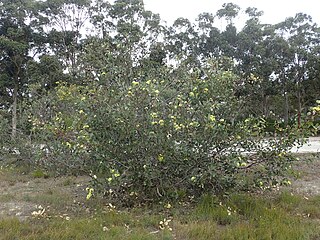
Eucalyptus preissiana, commonly known as bell-fruited mallee, is a species of small tree or shrub that occurs in an area between Albany and Esperance in Western Australia. It has a spreading habit, smooth bark, elliptical to egg-shaped or oblong leaves, flower buds in groups of three, yellow flowers and cup-shaped, conical or bell-shaped fruit.

Eucalyptus leptophylla, commonly known as the March mallee, slender-leaved red mallee or narrow-leaved red mallee, is a species of mallee that is endemic to inland Australia. It has smooth greyish bark, linear to narrow lance-shaped, oblong or curved adult leaves, flower buds in groups of between seven and thirteen, creamy white flowers and cup-shaped, barrel-shaped or hemispherical fruit.

Eucalyptus comitae-vallis, commonly known as Comet Vale mallee or Cowcowing mallee, is a mallee that is endemic to the south-west of Western Australia. It has rough, flaky to ribbony bark on the trunk and larger branches, smooth withish bark above, linear to narrow lance-shaped adult leaves, flower buds in groups of seven to eleven, white flowers and barrel-shaped, conical or cup-shaped fruit.
Eucalyptus blaxellii, commonly known as the Howatharra mallee, is a mallee that is endemic to Western Australia. It has smooth bark, linear to narrow lance-shaped adult leaves, flower buds arranged in groups of seven, white flowers and cup-shaped to conical fruit.
Eucalyptus limitaris is a species of tree or mallee that is endemic to north-west Australia. It has rough, flaky or fibrous bark on the trunk and branches, lance-shaped to curved adult leaves, flower buds in groups of seven on a branching peduncle and conical to barrel-shaped or cup-shaped fruit.
Eucalyptus misella is a species of mallee that is endemic to a small area of Western Australia. It has smooth, greyish bark, narrow oblong to narrow elliptical leaves, flower buds in groups of between seven and eleven, white flowers and flattened spherical fruit.
Eucalyptus olivina is a species of mallee or a tree that is endemic to Western Australia. It has smooth greyish bark, linear to narrow lance-shaped adult leaves, flower buds in groups of seven or nine, creamy white flowers and short barrel-shaped to cup-shaped fruit.
Eucalyptus perangusta, commonly known as fine-leaved mallee, is a species of mallee that is endemic to a small area on the south coast of Western Australia. It has smooth bark, glossy green, linear leaves, flower buds in groups of seven or nine, creamy white flowers and short, barrel-shaped fruit.
Eucalyptus planipes is a species of mallee that is endemic to Western Australia. It has smooth bark, lance-shaped adult leaves, flower buds in groups of three and conical fruit.
Eucalyptus rosacea is a species of mallee that is endemic to Western Australia. It has smooth, greyish bark, linear to narrow oblong adult leaves, flower buds in groups of seven, pink, red or cream-coloured flowers and flattened hemispherical to almost saucer-shaped fruit.
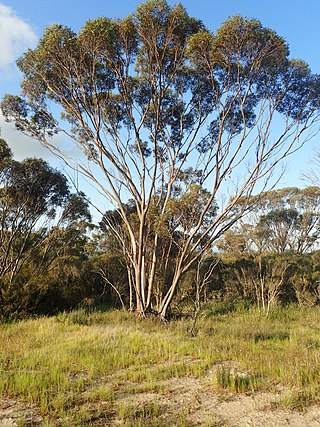
Eucalyptus scyphocalyx, commonly known as goblet mallee, is a species of mallee that is endemic to southern areas of Western Australia. It has smooth bark, lance-shaped adult leaves, flower buds in groups of three or seven, creamy white flowers and cup-shaped to cylindrical fruit.
Eucalyptus semota, commonly known as marymia mallee, is a species of mallee or small tree that is endemic to a small area in central Western Australia. It has rough, flaky to fibrous bark on the trunk, smooth grey or brown bark above, linear to narrow lance-shaped leaves, flower buds in groups of seven or nine, white flowers and conical to cup-shaped fruit.
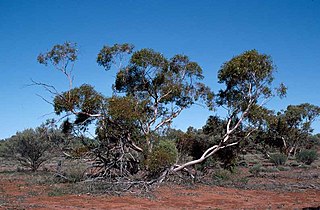
Eucalyptus concinna, commonly known as the Victoria Desert mallee, is a mallee or small tree that is endemic to Australia. It usually has rough, grey-brown on the lower part of its trunk, smooth bark above, lance-shaped adult leaves, flower buds in groups of between seven and eleven, white flowers and cup-shaped fruit. It has a widespread distribution in South Australia and Western Australia, centred on the Great Victoria Desert.
Eucalyptus conveniens is a species of small mallee or shrub that is endemic to a small area on the west coast of Western Australia. It has smooth bark, sometimes with a short stocking of rough bark near its base, lance-shaped to egg-shaped or elliptic adult leaves, flowers buds in groups of three, whitish flowers and glaucous, barrel-shaped fruit.
Eucalyptus delicata is a species of tree that is endemic to Western Australia. It has rough, fibrous to scaly bark on the trunk, smooth white to greyish bark above, linear to narrow lance-shaped adult leaves, flower buds in groups of between seven and eleven, creamy white flowers and more or less spherical to barrel-shaped fruit.
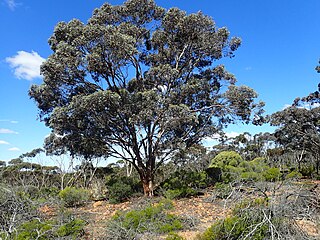
Eucalyptus densa is a species of mallee or mallet that is endemic to Western Australia. It has smooth greyish bark that is shed in curly strips, linear to narrow lance-shaped adult leaves, long, spindle-shaped flower buds in groups of seven or nine, pale yellow or lemon-coloured flowers and conical, cylindrical or barrel-shaped fruit.
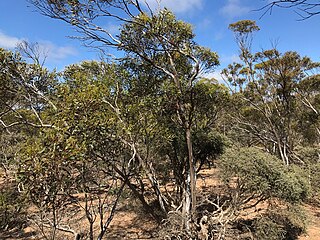
Eucalyptus depauperata is a species of mallee that is endemic to the south-west of Western Australia. It has spindly stems with smooth bark, linear to narrow elliptic adult leaves, flower buds in groups of seven, usually lemon-yellow flowers and conical to cup-shaped fruit. It is most common near Lake King.

Eucalyptus terebra, commonly known as Balladonia gimlet, is a species of gimlet that is endemic to Western Australia. It has satiny or glossy bark on its fluted trunk, linear to narrow lance-shaped adult leaves, flower buds in groups of seven, yellowish flowers and conical to hemispherical fruit. It is one of the seven species of gimlet.
Eucalyptus capitanea, commonly known as the desert ridge-fruited mallee, is a species of mallee that is endemic to South Australia. It often has rough, flaky bark on the lower part of the trunk, smooth bark above, lance-shaped adult leaves, ribbed, oval flower buds in groups of seven, cream-coloured flowers and ribbed, urn-shaped fruit.
Eucalyptus orthostemon, also known as diverse mallee, is a species of mallee that is endemic to the south-west of Western Australia. It has smooth coppery and greyish bark, linear adult leaves, oval to spindle-shaped buds in groups of seven, creamy white flowers and conical to cup-shaped fruit.








